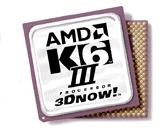| AMD vs. Intel: the AMD K6/2 350 by Ed "Lozhechnik" Reddy |
||||
|
 First I tested my AMD CPU at the factory default of 350MHz (see chart for details). To test the results, I used Sierra's Viper Racing which has a great tweaking utility, designed originally for slower machines, that measures frames per second (fps) performance using a pre-set race of approximately 15 seconds. In my tests, all graphic options were turned on, with the screen set at 1024x768 and run 10 times to give an average score. With the AMD set at the default factory setting of 350 MHz Viper Racing clocked-in at 51.2 fps. At a 380MHz it clocked-in at 47.2, an 8% decrease in fps due to the slower bus speed, and there was a slight CPU temperature change but the motherboard's temperature remained unchanged. The final test run was at 400MHz. At this setting Viper Racing clocked-in at 53.2 fps, a mere 4% increase over the default setting, with an accompanying 3 degree C. temperature increase on the CPU. However, during this last benchmark test, the system was showing signs of stress - a flash of white would appear suddenly during the test which effected the overall result. So, what's the upshot of all this, you ask? I came to two conclusions about the AMD and CPU's in general: 1. The AMD may be a truly lower-speed CPU - realistically, it's an overclocked 266 or 300MHz, labeled as a 350MHz. This would explain my inability to overclock the CPU by more than 15% as well as the mediocre performance gains. Without the use of extreme cooling methods, there is no benefit gained by overclocking an already taxed CPU. Kryotech sells overclocked AMD's in a system that employs freon-based CPU cooling systems. Their machines cool the CPU down to a butt-numbing -40°C! This configuration allows for the AMD K6/2 to be safely overclocked and significant performance gains realized. While their machines are praised for solid performance, this is not a cheap technology, adding hundreds to your costs. Hmm, that brilliant marketing strategy is coming apart at the seams now! Even overclocking has its limits, in this case pointing to AMD's less than stellar architecture for handling floating point calculations. Floating point numbers (those with fractional components) are used to produce all your 3D environments, graphics, and animations. Overclocking the CPU, therefore, can do little to improve upon a floating point architecture that is weak, which may also explain the AMD's poor results in our graphics intensive fps tests. |
 The latest from AMD. 2. A faster bus speed has a more favorable impact on game performance than a faster CPU frequency. I can just hear the engineers at AMD saying "Tell us something we don't already know," because AMD's K7 200MHz bus is already poised to dethrone Intel with the K7s release later this summer. And 3. um, I'll get to that in a moment. At this point in my learning curve, I realized what I was going to be writing here would be inflammatory to say the least, so I sent my test results to Drew Prairie from AMD, who commented on my test results. Tom's Hardware Misguide? Let's get Educated! According to Drew, if you are going to compare apples to apples it is important to have all your tests fairly done. It seems that AMD CPU's were improperly compared against Intel's on Tom's Hardware site. Drew mentioned three points that THW missed: A. TNT drivers have no support for 3Dnow! (Ed. Note: This recently changed with the release of the "Detonator" drivers.) Tom's Hardware used NVIDIA TNT video card chip sets to test 3D gaming. AMD has asked NVIDIA to offer support for 3Dnow! technology but had little success until recently. This means that THW use of TNT video cards was not accurate. B. Voodoo2 drivers are optimized for 3Dnow! technology. Had the comparison been done with a game that supports 3Dnow! with a Voodoo2 video card, the results would have been different. Drew mentioned that AMD's weaker Floating Point Processing would still have finished behind it's Intel counterpart, but not as indicated by THW site. C. The AMD is equal to the Intel in non-3D gaming performance. According to THW, this statement is true. The Intel PentiumII 350MHz was only 6.5% faster than AMD K6/2 350MHz at factory settings. The Celeron 333 and 366, however, did fair slightly better than the AMD (by a mere percent or two), driving home the point that the tests may have been done on an uneven battlefield.1 1. Drew Prairie, telephone interview by author, California, USA, 26 March 1999 Go to Page Four |
|||
|
Copyright © 1997 - 2000 COMBATSIM.COM, INC. All Rights Reserved.
Last Updated March 31st, 1999 |
||||

